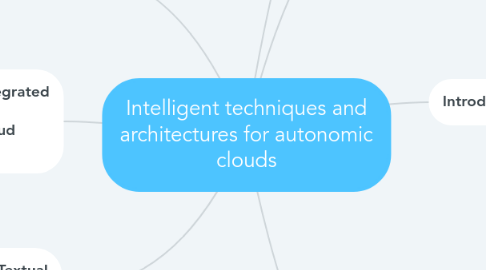Intelligent techniques and architectures for autonomic clouds
by Gerda Anciūnaitė

1. Context Caches in the Clouds
1.1. Context information is traditionally collected from distributed digital artifacts and services and made available to similarly distributed, and often mobile, context consuming applications via context brokers or servers.
1.2. It presented an investigation of the utility of various context-caching strategies and proposed the employment of a bipartite caching mechanism in a cloud-based context broker.
2. Abstract
2.1. Autonomic Computing introduces autonomy in software systems by making them capable of self- management and self-healing.
3. Introduction
3.1. Autonomic computing refers to principles and techniques for designing, building, deploying and managing computing systems with minimal human involvement.
3.2. Autonomic Clouds have emerged as a result of the application of autonomic techniques to cloud computing, resulting in robust, fault tolerant and easy to manage and operate cloud architectures.
3.3. The interplay of intelligent approaches and Clouds offers numerous challenges.
3.4. The international workshop on Intelligent Techniques and Architectures for Autonomic Clouds (ITAAC 2011) was held in association with 4th International Conference on Utility and Cloud Computing (UCC 2011)in Melbourne Australia to bring together researchers and practitioners across Cloud Computing, Intelligent Systems, and Autonomic Computing to discuss issues at the intersection of these disciplines.
4. Software Level Green Computing For Large Scale Systems
4.1. Green Computing addresses energy conservation in computer system by applying different techniques at software and hardware level.
4.2. Compiler distributes source code of software over a network, reshapes binary code by applying green strategies during code transformation at compile time and gives green suggestion to software programmer for energy conservation.
5. An Architecture for Integrated Intelligence in Urban Management using Cloud Computing
5.1. This paper advocates the application of cloud capacity to support the information, communication and decision making needs of a wide variety of stakeholders in the complex business of the management of urban and regional development.
6. Dot-base62x: A Compact Textual Representation of IPv6 Address for Clouds
6.1. With the transition from IPv4 to IPv6, services running in Cloud computing will face problems associated with IPv6 addressing: the notation is too long (39 bytes), there are too many variants of a single IPv6 address and a potential conflict may exist with conventional http_URL notation caused by the use of the colon (:).
6.2. Cloud computing will benefit most from the new, compact and user-friendly textual representation of IPv6 address proposed by this paper.
7. Intelligent techniques and architectures for autonomic clouds: introduction to the itaac special issue


